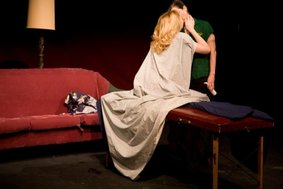
Back toward the end of the last century, I began a one-act play about a woman who needed to move. Since I am a rather literal writer, she needed to move out of her apartment. It was too full of things, and she couldn’t get out of there without someone’s help. I’d finally admitted to myself, and to someone else, that I wanted to love women. That someone was not at all gracious about it, and I was heartbroken. (And yes, a version of that is in another play).
I started the play as a way to get myself out of myself, and created a character who was going to be the catalyst for tremendous change in the woman who needed to move. I saw it as a sad and bloody play, perhaps with someone crying on the floor by the final curtain.
But about the time I conjured the mover, the real mover appeared. She and I began a relationship that continues to this day. I remember that spring as the one where my feet did not touch the ground. The new relationship was by far the most complicated one I’d ever been a part of.
I put it all into the writing, and surprised myself with a passion I didn’t know I had. This was the first play I’d written using all my senses. The previous ones had been muffled, compromised by my inability to see and hear and feel. This one would not be. Late one night I wrote “CURTAIN” and called it “The Space Between Heartbeats.”
 The first show we took to Dublin, "Some Are People."
The first show we took to Dublin, "Some Are People." I decided to produce it myself; I’d produced one 10-minute play at that point (still, we won Audience Favorite). So I called a friend with a theater and asked if I could put their company name on my application to the Samuel French Festival. I asked an acting class comrade (who’d directed my other piece) if he would take this one on as well. We got into the festival. We asked the artistic director of the theater whose name we were using to play the lead and she said yes. We asked a classmate of mine from playwriting class (who had an MFA in acting) to take the other part, and though she hadn’t set foot onstage in awhile, something made her say yes.
We rehearsed in unused rooms at my office at night, and I carried around bags of hand props and we tried to figure out how we were going to create the effect of a cluttered apartment onstage. This was the old Sam French Festival: The one at the American Theater of Actors where you might put your foot through the stage, and there were about a million plays in it, and about a hundred per evening, and you got 17-and-a-half minutes for tech. And one performance. You’d move on if the judges decided to take you to the next round.
The rehearsal process also taught me that you can only go as far as the actor wants to onstage. I had a picture in my mind of the very last moment of the play, which was meant to be intimate and nurturing, but neither of the cast members wanted to go there, and ultimately, the director worked up something they were comfortable with, and that’s what we did.
 This is the second show we took to Dublin, "The Adventures of..."
This is the second show we took to Dublin, "The Adventures of..." We did not move on in the festival, but I was determined to see the play done, and well, actually SEE it. I sent it in to a women’s festival, and it was chosen and a director was assigned.
You could call this production a “learning experience.” As in, that’s about the best you could say about it. I did learn a lot: that when you’re not happy with what’s going on in rehearsal, you should make it clear early and often. And that if you THINK you should pull the play, you probably should, even if the postcards are printed. And if it becomes apparent the director is uncomfortable with the material, and wants to cut most of it, RUN AWAY! RUN AWAY!
That experience led me to think there was something deeply wrong with the play, and I needed to rework it, or add more material so people would “get” what I was saying. I had to prove to…someone…that I was right. That I could do it. Eventually, I put the whole thing away, and worked on the next one.
I didn’t look at it again until I saw a call for submissions from a women’s theater company in London was looking for short plays for its scene showcase. The artistic director said she liked the piece, but could I cut it to fit their evening? I said I’d take a shot at it, and realized how much extraneous stuff there was (nothing like taking a couple years off from a play to see what you need to throw out).
The artistic director liked the new version, and I scraped up the miles to fly over to see it. I managed to stump the London cab driver I asked to take me to the theater, which is nearly impossible. But eventually we found it, and I was touched by the care they’d put into the production. Their accents were shaky, but their hearts were in the right place.
I brought the new version home, worked on it a bit more, and rechristened it “What to Throw Out.” And sent it out and sent it out and sent it out…I read it at playwrights’ circle; I considered producing it myself…but at that point, I’d had enough of the festivals and one-night stands, and hoping for an audience to vote you along to the next round.
 The third show we took to Dublin, "Outlook."
The third show we took to Dublin, "Outlook." So it became the play I sent when someone asked for a one-act two-hander, and there’s a monologue from it in an audition collection (it’s a good monologue).
Fast forward a few years (a refrain I often use in these postings. As my shrink says to me: Remember, Kathleen, living well really IS the best revenge!)
I have a wide and varied circle of theater friends and colleagues in various regions. Outside of New York City, the two places where my work gets produced most are Provincetown and Dublin. It’s kind of a self-perpetuating cycle, because who wouldn’t want to go back to a couple of wonderful towns where they like you?
Last spring, I caught up with a director I’d met at a women’s theater festival in Ptown. At that festival, there was a solo piece I really liked, and I tried to get someone in New York to do it. It took a couple of years, but it finally happened, and the Provincetown director, Margaret Van Sant, directed the piece in EAT’s New Works Series. “A Shining Attribute” is an excellent solo work, and I got a chance to meet and talk with the playwright, Candyce Rusk, who’d come in from Austin. This was on St. Patrick’s Day last year, and after the show was over, we repaired to perhaps the only bar in New York that wasn’t loaded with revelers.
Margaret told me to send up something for the next women’s festival and for the Playwrights Festival. We brought “Sharing the Pie” from NYC to Ptown in October, and “What to Throw Out” was accepted to the Playwrights Festival in November…with Margaret to direct.
 The fourth show we took to Dublin, "That's Her Way."
The fourth show we took to Dublin, "That's Her Way." But we found enough to make us excited that we began to talk about what we could do NEXT…and instigator that I am, I suggested we take this one and “A Shining Attribute” to Dublin as “Two from Provincetown.” It’s a compact ensemble: The director of “A Shining Attribute” and the actor double as the cast of “What to Throw Out.” I went home and did a solid rewrite, based on Margaret’s notes and my own observations. There are some damn transitions written in there now, I can tell you that.
We applied for and got into Dublin, and now we’re doing my usual spring fire drill of raising the money and buying plane tickets and renting an apartment and going into rehearsal again. A new piece I wrote got into the Provincetown Spring Playwrights Festival, so I’m going up in April to see it, and to check out where we are in rehearsal with “What to Throw Out.”
I leave from New York on May 9, and the Massachusetts crew leaves from Boston. Candyce leaves from Texas, and we will all end up in in Dublin on May 10. We have a day to get acclimated assemble any props and set pieces we need and get over the jet lag…fast. Tech is on Sunday, we open on Monday. And by the following Sunday, it’ll all be over, with the gala and the goodbyes; another festival, another production, extant only in the memory banks.
 Coming to Dublin, May 2014, "What to Throw Out."
Coming to Dublin, May 2014, "What to Throw Out." There is, of course, an Indiegogo campaign, that runs for another 10 days. If you are so moved, feel free to toss a few bucks our way. It will be put to good use, and you will get a postcard, written by hand, and delivered from over the ocean.
I hope to see you soon in Dublin, or New York, or Provincetown. Or anywhere else the words take me.
 RSS Feed
RSS Feed
